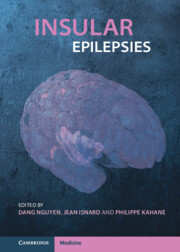Book contents
- Insular Epilepsies
- Insular Epilepsies
- Copyright page
- Contents
- Contributors
- Foreword
- Chapter 1 A Brief History of Insular Cortex Epilepsy
- Section 1 The Human Insula from an Epileptological Standpoint
- Section 2 The Spectrum of Epilepsies Involving the Insula
- Section 3 Noninvasive Investigation of Insular Epilepsy
- Section 4 Invasive Investigation of Insular Epilepsy
- Chapter 17 Invasive Investigation of Insular Epilepsy: Indications and Preplanning
- Chapter 18 Invasive Investigation of Insular Epilepsy: Surgical Techniques
- Chapter 19 Qualitative Interpretation of Intracranial EEG in Insular Epilepsy
- Chapter 20 Quantitative Intracranial EEG Signal Analysis in Insular Epilepsy
- Chapter 21 Electrical Stimulation of the Human Insular Cortex
- Section 5 Surgical Management of Insular Epilepsy
- Index
- References
Chapter 20 - Quantitative Intracranial EEG Signal Analysis in Insular Epilepsy
from Section 4 - Invasive Investigation of Insular Epilepsy
Published online by Cambridge University Press: 09 June 2022
- Insular Epilepsies
- Insular Epilepsies
- Copyright page
- Contents
- Contributors
- Foreword
- Chapter 1 A Brief History of Insular Cortex Epilepsy
- Section 1 The Human Insula from an Epileptological Standpoint
- Section 2 The Spectrum of Epilepsies Involving the Insula
- Section 3 Noninvasive Investigation of Insular Epilepsy
- Section 4 Invasive Investigation of Insular Epilepsy
- Chapter 17 Invasive Investigation of Insular Epilepsy: Indications and Preplanning
- Chapter 18 Invasive Investigation of Insular Epilepsy: Surgical Techniques
- Chapter 19 Qualitative Interpretation of Intracranial EEG in Insular Epilepsy
- Chapter 20 Quantitative Intracranial EEG Signal Analysis in Insular Epilepsy
- Chapter 21 Electrical Stimulation of the Human Insular Cortex
- Section 5 Surgical Management of Insular Epilepsy
- Index
- References
Summary
The accurate definition of the seizure onset zone (SOZ) is a central problem in drug-resistant epilepsies. Signal processing methods may be used to complement the interpretation of SEEG recordings by quantifying interictal events and SOZ. In this chapter, we will describe some of these methods and focus on insular epilepsies with some detailed case examples.
Keywords
- Type
- Chapter
- Information
- Insular Epilepsies , pp. 238 - 245Publisher: Cambridge University PressPrint publication year: 2022

